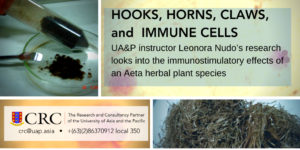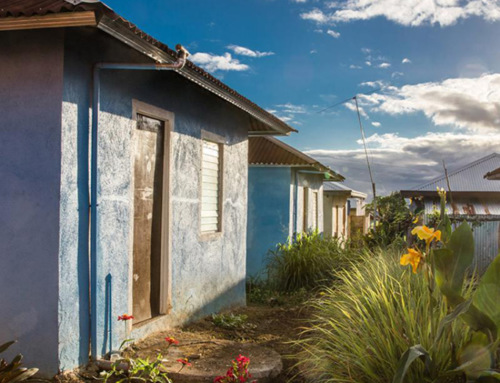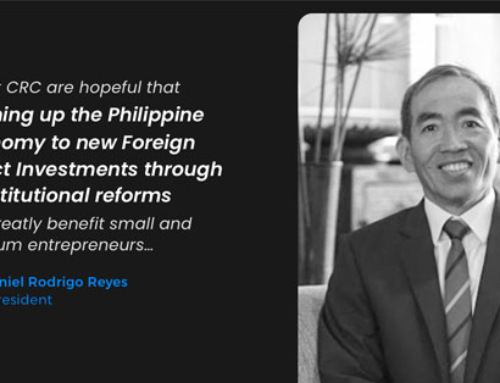This article was originally published on 2019-10-13 07:19:10
At first glance, the terms “uña de gato,” “sungay kalabaw” and “immunomodulation” might not seem like they have much in common – other than being unfamiliar terms to most people.
 But for Filipinos and other Asians who have medical conditions which require treatments to boost the immune system, that may be about to change. At least if research conducted by University of Asia and the Pacific instructor Ms. Leonora Nudo has anything to do with it.
But for Filipinos and other Asians who have medical conditions which require treatments to boost the immune system, that may be about to change. At least if research conducted by University of Asia and the Pacific instructor Ms. Leonora Nudo has anything to do with it.
Hooks, horns, claws and a new frontier. The therapeutic practice of “immunomodulation,” which involves regulating the responses of the immune system, is one of the most exciting frontiers of medical science today. Depending on a patient’s specific needs, it could involve boosting the patient’s immune system (immunostimulation) whenever it’s too weak; or it could involve curbing the patient’s immune responses a bit (immunosuppression) in cases when its effects, such as excessive inflammation, are too aggressive.
In cancer cases, for example, chemotherapy often leaves patients with weakened immune system, and immunostimulatory treatments could do a lot to help lower patient mortality.
Yet another example are those patients who have been exposed to “exotic” new diseases for which there aren’t any established therapies yet. Treatments to boost the population’s immune resistance could be a very useful first response until more effective cures can be found.
But what do “sungay kalabaw” and “uña de gato” have to do with all this?
“Sungay kalabaw” and “uña de gato” are both species of Uncaria – a genus of tropical flowering vines easily recognized through special hooked branches which allow them to cling to trees and other supports so that they can get from the soil up towards the canopy, where they can get better light.
Uña de gato (Uncaria tomentosa) is indigenous to the Amazon rainforest and the tropical areas of South and Central America, where indigenous peoples thought that its hooks looked like a cat’s claws – thus its Spanish name, which means “cat’s claw.”
“Sungay kalabaw” (Uncaria perrottetii), meantime, is native to the Philippine archipelago and the Island of Borneo. And where the indigenous peoples of the Amazon thought U. tomentosa’s hooks looked like a cat’s claws, the various indigenous peoples of the Philippines thought U. perrottetii’s looked like the horns of that ever-present behemoth of local agricultural life – the Philippine carabao (Bubalus bubalis).
What makes “sungay kalabaw” and “uña de gato” particularly interesting to modern-day medical scientists is that indigenous peoples around the world have been using many species in genus Uncaria for centuries as herbal medicines to boost the immune system.
A history of usefulness. This means that various Uncaria species are a potential source of compounds from which new immunostimulatory treatments and medicines can be developed. Existing studies of uña de gato have been particularly fruitful, resulting in the identification of a large number of “alkaloids, terpenes, quinovic acid glycosides, flavonoids, etc.” from a decoction of its bark or roots. As a result, uña de gato has become a common herbal supplement in the western hemisphere.
The problem for Asian patients is that “uña de gato” is hard to find and expensive to purchase here – requiring that the buyer pay for shipping across the Pacific Ocean.
Fortunately, Sungay kalabaw has a similarly long history of use among indigenous people – specifically the Aetas. Could treatments derived from sungay kalabaw turn out to be just as useful as those derived from uña de gato?
That’s where Ms. Nudo’s research comes into play.
During her initial data gathering, Ms. Nudo learned that the Aeta a tradition of using sungay kalabaw to promote healing from wounds, and for treating hematuria (bloody urine), and for combatting postnatal infections (puerperal sepsis) among new mothers. This corroborates existing early studies, which have shown that sungay kalabaw extracts demonstrate antimicrobial, antifungal, and antiprotozoal properties.
Keeping folkloric accounts and prior studies in mind, and using many methodologies that had originally been used to measure the immunostimulatory effects of uña de gato, Ms. Nudo designed a series of experiments which would determine whether exposure to a decoction made out of sungay kalabaw vine bark extract really does stimulate certain key processes of the immune system.
After getting permission and some assistance from the Aeta community in Sitio Kanawan in Morong, Bataan, she was able to acquire enough sungay kalabaw for the experiments.
Because these were some of the earliest experiments on the effects of sungay kalabaw extracts, albino laboratory mice were used in the tests, with procedures carefully reviewed and approved by an animal care and use committee.
Innate and adaptive immunity. Immunity in higher forms of animals involves two kinds of responses: innate and adaptive. After pathogens are detected in the body, the immune system quickly fights back using innate immune responses – generic responses which are meant to eliminate a broad range of possible pathogens. If this immediate response doesn’t get rid of the pathogen, then the adaptive immune responses kick in – specialised immune cells respond to specific pathogens using programmed responses which the immune system has “learned” over time.
These innate and adaptive responses can be tested by looking into key immune cell responses, of which Ms. Nudo’s study examined five: macrophage activation, phagocytic activity, the spread of lipopolysaccharide-sensitive lymphocytes, superoxide anion production, and increased levels of blood lysozyme.
Most of these tests looked into innate immune responses involving immune cells called phagocytes, which protect the body by “ingesting” foreign particles and dead or dying cells in a process called “phagocytosis.”
Under normal conditions, macrophages are present in a body’s tissues but simply lie dormant, passively clearing foreign material and dead cells. When the body is infected by a harmful pathogen, however, phagocytes are activated – expanding in size and producing more of the chemicals, the superoxide anion radicals, which they will later use to “kill” the pathogen. These phagocytes are drawn towards certain molecular patterns in the pathogen, and once they come in contact with it, the phagocytes stretch their cell membrane around the pathogen until it is completely engulfed. They then release the chemicals which “kill” the pathogen. And then the process continues until the infection has successfully been overcome.
Ms. Nudo’s tests checked to see if the sungay kalabaw extract stimulated the activation of macrophages, increased the “pathogen-swallowing” behavior of the phagocytes, and the phagocytes’ production of superoxide anions which they use to “kill” pathogens.
Another test looked into whether the sungay kalabaw extract helped stimulate a key adaptive immune response – the spread of lipopolysaccharide-sensitive B lymphocytes. Lipopolysaccharides (LPS) are a key component in the cell walls of gram-negative bacteria which activates macrophages and B lymphocytes when detected by the immune system. B lymphocytes produce antibodies that would target specific bacteria and viruses, so their increase is an indication that the adaptive immune system is at work. Recognizing the presence of pathogen is the immune system’s first step towards neutralizing it.
All of these tests involved collecting immune cells from the spleen and the membrane lining the abdominal cavity of the laboratory mice, but Ms. Nudo also wanted to see if the sungay kalabaw extract stimulated the production of lysozyme in the laboratory mice’s blood plasma. So Ms. Nudo’s study used a test commonly used test to determine its production by activated macrophages; she checked if the sungay kalabaw extract stimulated increased amounts of lysozyme – an antimicrobial enzyme used in breaking down pathogens – in the laboratory mice’s blood plasma.
A Question of Dosage. But before conducting all of these tests, Ms. Nudo needed to answer an important question: exactly what dosage of the sungay kalabaw extract should she use in the experiments?
In the case of uña de gato, traditional treatments had mentioned a specific dosage of extract, which was then applied to laboratory tests. But for sungay kalabaw, the folkloric accounts were less clear about what dosage of sungay kalabaw vine bark extract was supposed to be most effective.
So before Ms. Nudo could conduct the tests in live laboratory mice, she needed to conduct experiments that would determine the most effective dosage.
To do so, Ms. Nudo decided to conduct “in vitro” versions of the first four experiments, observing the effects of the sungay kalabaw extracts on pre-collected cells on laboratory receptacles to obtain more controlled results than could be obtained in live animals (referred to as “in vivo” testing).
These in vitro tests also served as a sort of preview for results that could be expected during later in vivo testing. The in vitro tests would document the effects of the sungay kalabaw extract on isolated immune cells, while the in vivo tests would document whether those same effects would be observed under “real-life” in vivo conditions.
The in vitro tests. The first of the in vitro tests checked whether exposure to the sungay kalabaw extract enhanced the activation of macrophages from the membrane lining the abdomen of the mice. This was measured in terms of the number of macrophages that exhibited “cell spreading” – essentially, that they had expanded.
The results of this first test were very encouraging: exposure to the sungay kalabaw extract greatly enhanced the number of macrophages which exhibited cell spreading.
Ms. Nudo then conducted a test to see if exposure to the sungay kalabaw extract enhanced the phagocytes’ ability to engulf (“phagocytose”) foreign cells. She introduced heat-inactivated yeast cells to various immune cells taken from the mice spleens – some of which were exposed to sungay kalabaw extract, and some of which were not. She then counted the number of cells that “swallowed” yeast cells, to see whether this behavior was more prevalent among the phagocytes in the samples exposed to sungay kalabaw extract.
This test showed promise too, because exposure to sungay kalabaw extract clearly increased the number of phagocytes which phagocytosed the yeast cells. But this test also resulted in a surprise: while exposure to sungay kalabaw extract generally increased the number of cells which phagocytosed yeast cells, the enhancement was not significantly different for concentrations of extract higher than 10 microliters/mL.
Ms. Nudo’s third test then checked if exposure to the sungay kalabaw extract enhanced the proliferation of lymphocytes sensitive to lipopolysaccharides (LPS) – a key component in the cell walls of gram-negative bacteria.
This test also proved very successful, with exposure to sungay kalabaw extract clearly raising the count of LPS sensitive lymphocites in samples taken from the mice spleens.
The final in vitro test checked whether the sungay kalabaw extract led phagocytes isolated from the mice spleens to increase their production of superoxide anion radicals – a chemical substance which phagocytes use to kill bacteria.
Here, too, the sungay kalabaw extract showed clear immunostimulatory effects, with the samples exposed to sungay kalabaw extract showing a marked increase in the production of superoxide anion radicals.
Testing “in real life”. With in-vitro tests showing so much promise, the next question was whether the in vitro test results would also be reflected in tests on live organisms. No matter how promising the in vitro results looked, the in vivo testing would determine whether sungay kalabaw is really worth exploring as a possible alternative to uña de gato.
Factoring in all of the results of the in vitro tests, Ms. Nudo determined that the ideal dosage for the decoction was 50 micrograms per mL, which would be adjusted to the body weight of the experimental animal. She then conducted all four tests once again. But where the in vitro tests had exposed immune cells to the sungay kalabaw extract, the mice were now injected with carefully prepared sungay kalabaw decoction over a period of ten days.
On the eleventh day, the immune cells were collected, and the effects of the sungay kalabaw extract were observed by performing the assays ex vivo. One by one, the results of the test corroborated the findings of the in vitro experiments.
Observations of the phagocytes gathered from the mice spleens and abdominal linings showed that the sungay kalabaw extract clearly enhanced macrophage activation, phagocytosis, B lymphocyte proliferation, and superoxide anion production.
For these in vivo versions of the tests, Ms. Nudo exposed the mice to a chemotherapy drug called cyclophosphamide (Cy), which also has the effect of suppressing the immune system, which allowed her to observe the effects of exposure to the decoction clearly. In each case, the sungay kalabaw extract significantly reversed the immunosuppressive effect of the Cy.
On top of these first four tests, though, Ms. Nudo undertook one more test on the in vivo effects of the sungay kalabaw extracts – one which she could not have conducted using in vitro methods. She checked to see if mice which had been injected with the sungay kalabaw decoction had increased amounts of lysozyme, an enzyme used in killing pathogens, in their blood plasma.
In this last in vivo test, too, the decoction was showed to have a stimulating effect. Ms. Nudo tested the decoction on mice whose immune systems had been suppressed using Cy. And mice that had been exposed to sungay kalabaw decoction produced significantly higher levels of lysozyme in their blood, compared to Cy-treated mice which had not been injected with the sungay kalabaw extract.
Moving forward. Overall, Ms. Nudo’s study clearly showed that sungay kalabaw extract really did boost the immune system of the animal model. This suggests that research can move forward to see if sungay kalabaw can be used as a herbal supplement in Asia, the way uña de gato is being used in South America.
The research also helps open the door for various molecular components derived from the two species to be used in the development of new medications – although a lot more research still has to be done before that happens.
The study did produce one surprise in particular – that the boosting effect the extract had on engulfing behavior of phagocytes stopped being greater at concentrations of more than 10 microliters per mL. This effect was out of the scope of Ms. Nudo’s study, so it will have to be examined by future researchers.
In the meantime, patients in need of immunity-boosting treatments might have something to look forward to.
One group which might particularly benefit are patients who are undergoing chemotherapy for cancer. While cyclophosphamide is used in chemotherapy to kill cancer cells, it also suppresses the immune system. And many of the deaths of patients undergoing chemotherapy are actually the result of suppressed immune system.
Cyclophosphamide – Cy – was precisely the same chemical used in Ms. Nudo’s experiments to suppress the laboratory mice immune system, before the effects of sungay kalabaw extract were tested. And those results came back showing that the mice immune system, suppressed by Cy, were given a boost by the effects of sungay kalabaw.
It will take some testing first, of course, before sungay kalabaw can be turned into a herbal supplement. Among the most important such tests will determine what risks the extract presents for human beings, for example. And since the process of extracting the sungay kalabaw decoction is still very crude, studies would have to be made on how the extraction process could best be done.
For now, though, one thing is for sure. Thanks to Ms. Nudo’s study, the immunostimulatory effects of sungay kalabaw aren’t just the domain of Aeta folklore anymore. And patients in need of immunity-boosting treatments would be wise to become familiar with the term “sungay kalabaw.” • Remi E. De Leon/CRC
———————————————
The Center for Research and Communication (CRC) is a research and consultancy group that partners with the University of Asia and the Pacific (UA&P), drawing upon UA&P’s considerable human and knowledge resources to meet the research needs of businesses and development agencies throughout the Philippines. To find out more about CRC’s work and its various researchers and consultants, you can contact Communications Officer for Research, Mr. Remi de Leon, by email at [email protected].
This article is based on an article published in the Journal of Ethnopharmacology. More information about the original journal article can be found here.






